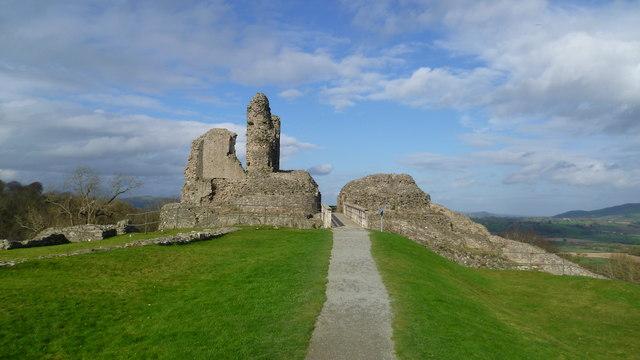
The ruins of Montgomery Castle provide scenic views across the surrounding countryside. Built by the Normans in the 11th century shortly after their conquest of England, Montgomery Castle was strategically sited to control major routes along the Welsh-English border.
Why was Montgomery Castle built?
With its massive stone keep, curtain walls, towers and imposing gatehouse, Montgomery Castle was a formidable stronghold designed to project Norman power. Over the following centuries, control of Montgomery Castle shifted between English and Welsh forces during periodic conflicts, with the castle changing hands several times.

Though now an atmospheric ruin following its destruction in the 17th century, Montgomery Castle’s site continues to dominate the landscape, reminding visitors of its strategic importance. Its remains tell the storied tale of Norman ambition and medieval English-Welsh struggle for domination.
The Strategic Position of Montgomery Castle
Montgomery Castle occupies a naturally strategic location that gave it key advantages:
- Elevated Site – The castle was built atop a high rocky outcrop providing strong natural defenses, including steep slopes and cliffs protecting three sides.
- Route Control – The site controlled an important intersection of routes between northeast Wales and England’s West Midlands region. Patrols could monitor movement.
- Proximity – Though located inland, Montgomery Castle was close enough to the English border to allow rapid reinforcements from English garrisons if needed.
- Commanding Views – The elevated perch afforded panoramic views for miles in all directions, allowing defenders to spot approaching forces.
- Psychological Dominance – The imposing castle atop the outcrop intimidated and dominated the surrounding Welsh countryside as a projection of Norman England’s military might.
Montgomery Castle’s hilltop position maximised both its defensive capabilities and ability to project authoritarian power over the adjacent lands and roads.
Features and Layout of Montgomery Castle
Montgomery Castle incorporated several key defensive and residential features in its design:
- Stone Keep – At the highest point sat a massive square stone keep over 50 feet tall, serving as the innermost stronghold and lookout.
- Curtain Walls – Circular curtain walls up to 10 feet thick encircled the grounds with crenelated battlements and towers for archers.
- Gatehouse – A large stone gatehouse controlled entry over an outer drawbridge and iron portcullis, flanked by two towers.
- Inner Ward – The inner bailey or ward included a great hall, kitchens, well, chapel and accommodations for the lord’s household.
- Outer Ward – The outer ward housed stables, kennels, storage sheds and soldiers’ quarters.
- Water Supply – An ingenious dual well and cistern system provided fresh water and storage during potential sieges.
Montgomery Castle’s formidable construction enabled it to withstand attack while dominating the surrounding region.
History and Conflicts of Montgomery Castle
As a strategic stronghold in the Welsh Marches, Montgomery Castle’s history was shaped by centuries of English-Welsh conflict:
- Norman Construction – Montgomery Castle was built by the Normans in the late 11th century to consolidate their control of central Wales after invading England in 1066.
- Medieval Struggle – As English and Welsh factions struggled for control of Wales over the next centuries, Montgomery Castle changed hands multiple times, besieged in 1165 and 1215.
- Glyndŵr Revolt – The castle was captured by forces of Welsh rebel Owain Glyndŵr in 1402 before being retaken by the English.
- Civil War – During the English Civil War in 1644, Montgomery Castle was held by Royalists until surrendering to Parliamentarians in 1645, after which it was partly demolished.
- Modern Ruin – Largely abandoned since the 17th century, substantial portions of the curtain walls, towers and gatehouse still stand today as dramatic ruins.
Montgomery Castle’s long history of conflict provides insights into the prolonged struggle between England and Wales for control of the Welsh Marches frontier.
How to find Montgomery Castle
Map to Montgomery Castle Map and directions
Montgomery Castle address Montgomery Castle, Castle Walk, Montgomery, Powys, Wales, SY15 6ES, United Kingdom
Find somewhere the stay
Related Articles
The Middle Ages in England
The Middle Ages in England span from around 500-1500 AD, covering over 1000 years of English history.
Uncovering the Hidden Histories of England and Wales’ Overlooked Castles
Many lesser-known castles around England and Wales have their own unique histories that are fascinating to uncover.
5 Facts About the Tower of London
Discover the rich history and secrets with these 5 fascinating facts about the Tower of London, a symbol of royal power and intrigue for centuries.





